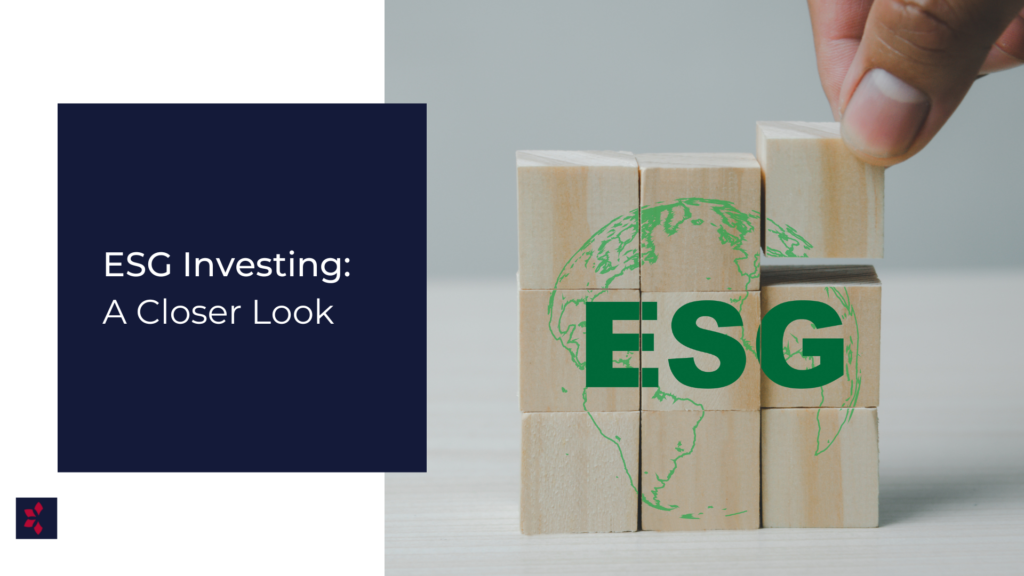ESG Investing: A Closer Look

ESG investing, the acronym for Environmental, Social, and Governance investing, is becoming a bigger focus in the media. While some investment managers solely focus on ESG in their investment selection process, others may only focus on one part of ESG such as Governance.
This article discusses the rise of ESG investing, the ESG framework, and proposals to enhance ESG disclosure to investors.
The Rise of ESG Investing
ESG investing has increasingly taken on prominence as an investment concept, deriving from sustainable and socially responsible investment criteria initiated a few decades ago.
Launched in 2006, the UN Principles for Responsible Investment (PRI), an international organization, engages in promoting the incorporation of environmental, social, and corporate governance factors (ESG) into investment decision-making.
In 2020, net inflows into ESG funds in the U.S. reached $51.1 billion, a significant increase over 2019 when flows equaled $21.4 billion, which itself was a record.
Source: Morningstar. Data as of 12/31/2020.
The ESG Framework
There are many factors that can be considered in applying an ESG investment framework. Here are a few examples:
Environmental: What impact does a company have on the environment?
- Climate change policies
- Greenhouse gas emissions
- Carbon footprint and carbon intensity
- Water usage and conservation and waste disposal
- Renewable energy usage
- Green products, technologies, and infrastructure
- Employee incentives promoting carpooling, public transportation, bicycle commuting, etc.
- Relationship with environmental regulatory agencies
Social: How does a company improve its social impact within the workplace and as part of the broader community?
- Employee treatment and compensation
- Employee engagement and turnover
- Employee training and development
- Employee safety policies and sexual harassment prevention
- Diversity and inclusion in hiring, promotions and pay increases
- Ethical supply chain sourcing
- Mission or higher purpose
- Customer service performance
- Customer protection activity, including lawsuits, recalls, and regulatory penalties
- Lobbying efforts and public stance on social justice issues
Governance: How does the company’s board and management drive and manage positive change?
- Executive compensation, bonuses, and perks—whether they are tied to long-term business value
- Policies that define and enforce ethical business practices
- Diversity of the board and management team
- Potential conflict of interest for board members
- Shareholders’ ability to nominate board candidates
- Whether term lengths differ among board members
- Separation of chairman and CEO roles
- How board votes are decided—by a majority or by who receives the most votes
- Whether company issues dual or multiple-class stock
- Transparency of shareholder communications
- History of shareholder lawsuits
- Status of regulatory licenses/filings and regulatory agency relationships
A company’s environmental and social goals are all tied to the presence of a strong corporate governance. At Bloom Investment Counsel, Inc., we employ a rigorous bottom-up security analysis of every stock before it is selected for our clients’ custom-built dividend-paying portfolios.
Investing is about selecting the best managed companies, and increasingly the best managed companies have good corporate governance practices.
We believe that companies who do not implement good corporate governance practices face the negative cost and risk of not embedding this in their operations, driven by customer and employee expectations, among other factors. These can ultimately negatively impact a company’s bottom-line, and as a result its sustainable growth.
Further, as a part of Bloom Investment Counsel, Inc.‘s 37-year history of building personalized portfolios, we work together with our high-net-worth clients to understand their unique long-term financial needs, objectives, and goals, as well as preferences and constraints on their invested capital, ensuring all investments align based on their personal or familial values.
Proposals to Enhance ESG Disclosure to Investors
In a May 25, 2022 press release, the SEC proposed that funds that are branded as ESG funds or claim to apply ESG factors for security selection would have to abide by regulated disclosure criteria to apply consistent, comparable, and reliable information for investors. Rules already exist for funds with respect to their capitalization claims. This proposal will be published in the U.S. Federal Register for a 60-day comment period.
On January 19, 2022, the Canadian Securities Administrators (CSA) published guidance on ESG disclosure by investment funds.
“Right now, ESG investing in mutual funds and ETFs is the “Wild West” due to the voluntary nature of ESG-related disclosures, absence of widely accepted terminology, and limited to no enforcement.” – Andrew Bahar, CEO of As You Sow
Outside of investment funds, the CSA published consultation paper proposing that all public companies be required to make climate-related disclosures informed by the Task Force on Climate-related Financial Disclosures, but with significant reductions in scope. However, industry responses demonstrated that the requirements were not considered stringent enough, indicating a strong appetite for robust climate-related disclosure.
This content is provided for general informational purposes only and does not constitute financial, investment, tax, legal or accounting advice nor does it constitute an offer or solicitation to buy or sell any securities referred to. Individual circumstances and current events are critical to sound investment planning; anyone wishing to act on this content should consult with his or her financial partner or advisor.